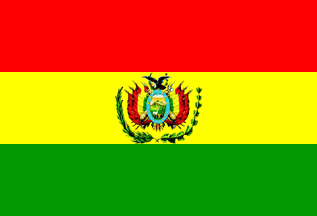Top Qs
Timeline
Chat
Perspective
Military ranks of Bolivia
From Wikipedia, the free encyclopedia
Remove ads
The Armed Forces of Bolivia has four main branches: Army, Navy, Air Force and the National Police Force. Each of the four branches has a similar structure,[1] each having four pay grades: non-commissioned officers, senior non-commissioned officers, commissioned officers and general staff. However, the SNCO roles vary depending on the branch; some of these hold specialisations.

Remove ads
Army
Summarize
Perspective
The Army trains all its personnel in the following:
- Army NCO School, Sucre
- Military College of Bolivia, La Paz
Officer ranks
Enlisted ranks
Remove ads
Navy
Summarize
Perspective
Despite being a landlocked country, Bolivia has a large quantity of rivers and lakes which the majority of their naval operations take place on, one example of this is Lake Titicaca,[4] which is shared between Bolivia and Peru.
The Navy, unlike the other three branches, has different specialisations for the NCOs and SNCOs once they reach the rank of 'seaman'. Once a specialisation has been achieved, the sailors' insignia will be adjusted slightly, to make his/her profession more visible. Those corps are as follows:
- Machinist Corps
- Medical Corps
- Divers Corps
- Logistics Corps
- Quartermasters Corps
- Signals Corps
Any rank between Seaman and Master Chief Petty Officer can have a specialisation as part of their regular rank insignia, the only corps where the insignia varies is within the Machinist Corps, where both NCO and SNCO have a different insignia, this also helps determine their qualifications and what they are responsible for.
The most Senior Non-Commissioned Officer, Fleet Master Chief Petty Officer, holds no specific specialisation. The SNCO would have been a specialist at a lower rank. This sailor would also be the overseer of each of the Corps, ensuring that this branch's members are fully trained and equipped.
Officer ranks
Enlisted ranks
Remove ads
Air Force
Officer ranks
Enlisted ranks
Honorary ranks
In the Armed Forces, the title Marshal is a military distinction granted to generals for exceptional achievements and it is used to denote a senior military leader. Unlike other military titles named "marshal", it is not a military rank. Six individuals in the history of Bolivia have been assigned the rank: Antonio José de Sucre, Marshal of Ayacucho; Andrés de Santa Cruz, Marshal of Zepita; Otto Philipp Braun, Marshal of Montenegro; José Ballivián, Marshal of Ingavi; Bernardino Bilbao Rioja, Marshal of Kilometer 7 ;[8] and Juana Azurduy de Padilla, Marshal of the Greath Fatherland (posthumous).[9]
Remove ads
Historical ranks
Summarize
Perspective
The ranks were introduced in 1968, based on design by the Central American Defense Council (Spanish: Consejo de Defensa Centroamericano; CONDECO).[10]
- Officers
- Enlisted
Remove ads
References
Wikiwand - on
Seamless Wikipedia browsing. On steroids.
Remove ads





























































































































